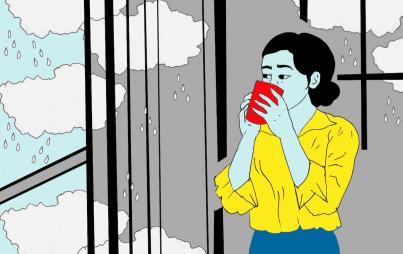
At the time, no one could tell me why I was suddenly visiting the ER on a monthly basis. Image: Thinkstock
Once our body’s stress system is impaired, it remains in a constant state of stress.
I was what you would call a sickly child: severe allergies, persistent throat infections, insomnia, and digestive issues plagued me before the arrival of Kindergarten.
As I approached adolescence, migraines took over and became the primary focus. My pediatrician sent me to every specialist available, with the exception of a therapist or mental health expert.
To my doctor, the migraines made no sense, and all other ailments were overshadowed while he gave me new diets and medications to try.
Nothing worked, and the mystery remained unsolved as I aged out of his office. As I moved into adulthood, I tried new medications and new doctors, but at this point my body was rebelling in a different way. Before the age of 24, I would be diagnosed with Stage Four Endometriosis and Crohn’s Disease.
Throughout the many hospital and doctor visits, procedures and surgeries, I was only ever asked about the history of cancer or heart disease in my family. At the time, no one could tell me why I was suddenly visiting the ER on a monthly basis. My primary doctor sent me for tests and procedures, and referred me to specialists constantly.
Prescribe, refer, repeat — that was the drill for several years.
It wasn’t until I started to explore the impact of childhood adversity that I saw the big picture and it began to make sense.
Childhood Disrupted explores the ways in which the CDC’s Adverse Childhood Experience (ACE) study predicts physical and mental health outcomes, by showing the correlation between a high ACE score and a significant number of doctor visits.
For each ACE score a person had, the chance of that person being hospitalized with an autoimmune disease as an adult rose 20% (pg.463). One study in particular found that in the 15,357 adults who completed the ACE survey, 64% reported one ACE, and had their first hospitalization by age 31.
There are ten questions on the ACE survey, all pertaining to abusive and toxic behaviors which occur around a child before the age of eighteen. For each question, or ACE, a person answers in the affirmative, a point is given. The questions apply to emotional and physical abuse, but they also pertain to a child witnessing domestic violence, substance abuse, and criminal activity.
The book explains how the HPA (Hypothalamic-Pituitary-Adrenal) stress axis, which regulates the hormone levels associated with immunity, digestion, energy, sex, and stress, can be changed permanently when it is overloaded during childhood and teenage years.
Mothers who have three or more ACEs are more likely to experience mental health problems a year after giving birth. The children of those mothers were also more likely to be hyperactive, to have anxiety disorder and other personality or behavioral disorders, and to be physically aggressive.
This long-term change creates a new physiological set point for our endocrine and immune systems, causing them to turn out “damaging cocktails of stress neurochemicals that barrage our bodies and cells when we’re 30, 40, 50, and beyond.”
Once our body’s stress system is impaired, it remains in a constant state of stress. Dr. Nadine Burke Harris, a proponent of incorporating the ACE study into pediatric care, explained this best in her TEDMED talk:
Well, imagine you're walking in the forest and you see a bear. Immediately, your hypothalamus sends a signal to your pituitary, which sends a signal to your adrenal gland that says, ‘Release stress hormones! Adrenaline! Cortisol!’ And so your heart starts to pound, your pupils dilate, your airways open up, and you are ready to either fight that bear or run from the bear.
And that is wonderful if you're in a forest and there's a bear. But the problem is what happens when the bear comes home every night, and this system is activated over and over and over again, and it goes from being adaptive, or life-saving, to maladaptive, or health-damaging.
Children are especially sensitive to this repeated stress activation, because their brains and bodies are just developing. High doses of adversity not only affect brain structure and function, they affect the developing immune system, developing hormonal systems, and even the way our DNA is read and transcribed.
Even though I became slowly aware of my anxiety as an adult, it was only on a surface level, a visible trigger to avoid with alternative treatments. After reading Childhood Disrupted and similar research, I realized that I, like many of the people profiled in the book, still have deeply-buried anxiety.
The body never forgets, and with the discussion about ACEs expanding, we can look at the big picture of our health.
Part of that picture includes our own parents and their ACE scores. Research shows that mothers who have three or more ACEs are more likely to experience mental health problems a year after giving birth, in addition to a severe blow to their confidence as a parent. The children of those mothers were also more likely to be hyperactive, to have anxiety disorder and other personality or behavioral disorders, and to be physically aggressive.
Dr. Burke Harris created the Center for Youth Wellness to treat patients based on their ACE score, tailoring each child’s medical care to their experience. She says that one of the reasons the ACE study has been slow to take over the medical industry is the fact that many people don’t think high ACE scores could apply to them.
She demonstrates this during her Ted talk by asking the audience members general questions about their childhoods, questions she insists apply to the majority as opposed to the minority (How many of you had a parent who sometimes drank too much? How many of you grew up with a parent who has a mental illness?).
The good news is that more states are implementing the ACE study into parenting courses, and progress is being made.
I hope to visit a physician someday who will ask me about my ACE score, or who will consider my background when they approach my medical care.
In the meantime, I am going to try some of the healing exercises Childhood Disrupted offers. I’m not expecting a medical miracle, but I can now look forward with some hope that things will change.
Sources:
Nakazawa, D. J. (n.d.). Childhood disrupted: How your biography becomes your biology, and how you can heal.
Dube, S. R., Fairweather, D., Pearson, W. S., Felitti, V. J., Anda, R. F., & Croft, J. B. (2009). “Cumulative Childhood Stress and Autoimmune Diseases in Adults.” Psychosomatic Medicine, 71(2), 243-250. doi:10.1097/psy.0b013e3181907888
When Bad Things Happen to Good Girls — And Then They Grow Up. (n.d.). Retrieved May 25, 2016, from http://blogs.psychcentral.com/womens-mental-health/2016/01/when-bad-things-happen-to-good-girls-and-then-they-grow-up/







